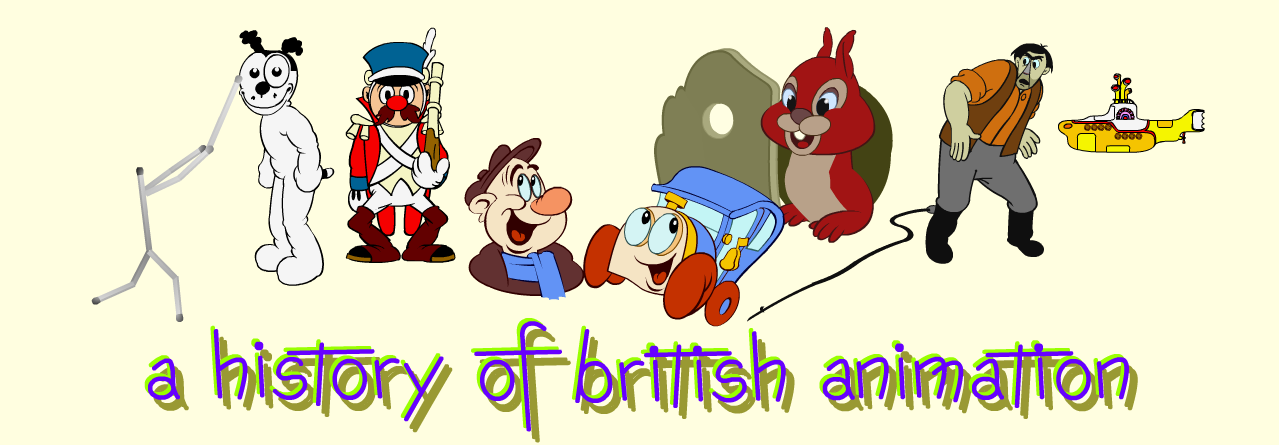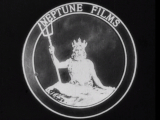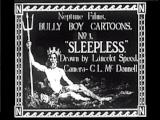

|
 | NEPTUNE FILM COMPANY LTD(1914-1921) |  |
||
|
After working for the newly-formed London Film Company during 1913, John East and Percy Nash found themselves at odds with company directors Ralph Jupp and Ralph Dewsbury. They decided they could do better themselves, and with financial support from businessman Arthur Moss Lawrence and barrister Thomas Lennox Gilmore they built a studio at Boreham Wood, opening the Neptune Film Company in January 1914. These were live-action film companies, but Neptune seems to have had an early connection with animation. The illustrator Lancelot Speed was asked to design a logo for the new company and, according to an account in The Bioscope (5 November 1914) "for the better part of two years" he had been "experimenting exhaustively in trick drawing for the screen." It would seem that he had been making cut-out animations, and it may be that the animated logo seen at the end of his subsequent cartoon film for Neptune, Bully Boy, was created for the company in the early part of 1914. (I have been unable to find an instance of Neptune's logo on any earlier live-action production.) With the outbreak of the First World War the 'Lightning Artist' film (an enhanced version of the stage act with undercranking of the camera speeding up the process of drawing) was revived as a means of presenting propaganda cartoon images. Neptune turned to Speed to provide such films for them, pairing him with cameraman Claude Leonard McDonnell. Speed's first film, Bully Boy begins as a typical 'Lightning Artist' film with Speed shown drawing images of the Kaiser, Rheims Cathedral and a German cannon. But now the pictures take on a life of their own. Simple bits of animation — cutout flashes and falling masonary, sheep's wool for smoke — show the shelling of the cathedral. More complicated work — progressive overpainting and some cutout animation — create the Kaiser's changes of expression. Finally, full cutout animation depicts the British Bulldog pouncing on and devouring the German Sausage. Bully Boy was released on Monday 12 October 1914 [Rachael Low, The History of British Film (Volume 3)] after a preview at the Shaftesbury Avenue Pavilion on Friday 2 October [Denis Gifford]. The Bioscope (8 October 1914) gave this glowing review: Considerably the wittiest and most ingenious topical skit that we have hitherto seen. It deals with the destruction of Rheims Cathedral by the modern Attila, and concludes with an amazingly realistic reproduction of the British Bulldog consuming the German Sausage. The living line drawings in which these subjects are dealt with are executed with remarkable ability by Mr Lancelot Speed. Although keen and stinging, the humour of the pictures never degenerates into mere vulgarity. Due, I presume, to the success of the film, Neptune Films suggested that 'Bully Boy' be used as the series title for Speed's further films. Bully Boy Cartoons No. 2, French's Contemptible Little Army (an epithet attributed to the Kaiser but probably invented by a British propagandist, using a phrase which had historical resonance at the time) and No. 3, Sleepless, were released at roughly fortnightly intervals according to Gifford, 24 October and 5 November. On the latter date The Bioscope carried an interview with Speed in which he says "I am, so far, satisfied if I can manage to produce a 'Bully Boy' cartoon in a fortnight." The distributor's schedule of a new release every two weeks was becoming standard practice for short film series production, but this was not to be the case with the Bully Boy series. No. 4, Sea Dreams, was not released until 10 December, No. 5, A Chip Off the Old Block; or, The Half-a-Crown Prince on 18 January, No. 6, The Jolly Roger, not until 17 April, and No. 7, Turkish Delight, on 5 May. While other events may have contributed to this sporadic release pattern, the main reason would seem to be the desire to improve and increase the complexity of the animation — maybe even to the point of reshooting sequences that fell short of the standard of previous entries. Although still retaining the initial live-action 'lightning artist' element — which not only padded out the footage but established the premise of drawings coming to life, as well as allowing the artist to be seen by his public — it is clear that Speed wants to have his characters fully act out the scenario. For Neptune the irregular delivery of the films could be off-set by their quality — the emphasis on animation lifted the Bully Boy series head and shoulders above the other 'Lightning Artist' propaganda films, as the trade magazine reviews bear out: Mr Speed is an exceedingly clever draughtsman who has been able to appreciate to the full the unique possibilities offered by the moving picture camera in conjunction with work of this sort. Possessed thus of every advantage he is taking this new form of comic pictorial art several steps further forward than it has yet been developed. [From review of Bully Boy No. 2, Bioscope 29 October 1914.] There is no better cartoonistic work on the screen anywhere than that put into this series by Mr Speed. [From review of Bully Boy No. 4, Pictures & Picturegoer 7 January 1915.] Bully Boy Cartoons are so successful that one sees them in almost any picture show one visits, and very frequently they form a turn at some of the best music halls. [From review of Bully Boy No. 5, Pictures & Picturegoer 6 February 1915.] The sixth and in all probability about the most amusing of this famous series by Lancelot Speed. Topical and typical of this clever artist's style. [Bioscope 1 April 1915.] There is another factor that might have caused Speed to hold back delivery of his films: cash flow. Although the War had a short-term negative effect on production companies, it was the increasing number of companies, and the resulting increase in film production, that was the real problem. Exhibitors could choose from many new releases each week, both domestic and foreign. Because of a larger domestic market, films from the USA had usually recovered their production costs and could be offered in foreign markets at a reduced rate. British films could take a long time to recover their production costs, and profits might come too late to save a company unable to pay its bills. By the summer of 1915 it would seem that Neptune was underfunded. According to Gifford, the Trade Show for Bully Boy No.8 was scheduled for 21 May but was posponed to 25 June. I am inclined to think that Speed may have been withholding the film, or completion of it, until he received payment for previous entries. In August, after a difference of opinion with the board of directors, Percy Nash left the company to continue his career as a film director elsewhere. Nash had been the driving force of the Neptune Film Company, directing most of the films himself, but he had not invested any money in the company. He had probably been resposible for approaching Speed in the first place and I imagine he had acted as producer on the Bully Boy series. The unnamed No. 8 was never released, and the series ended. The Neptune Film Company tried to work its way out of trouble with the help of Barker Motion Photography Ltd who made a series of films at Neptune Studio in co-production with Neptune and directed by Fred W Durrant. However, the Neptune Film Company finally ceased production in 1917 and went into liquidation in 1920. Claude McDonnell continued work as a cinephotographer, and shot some of Alfred Hitchcock's early films at Gainsborough Pictures. |
Filmography (animated films only) | ||||
| Bully Boy | 1914 | |||
|---|---|---|---|---|
| Producer/Writer/Director/Animator: | Lancelot Speed | |||
| Camera: | Claude L McDonnell | |||
| Colour: | Black & White | |||
| Length: | 435 ft | |||
| Release Date: | 12 October 1914 | |||
| French's Contemptible Little Army (Bully Boy No. 2) | 1914 | |||
| Producer/Writer/Director/Animator: | Lancelot Speed | |||
| Camera: | Claude L McDonnell | |||
| Colour: | Black & White | |||
| Length: | 375 ft | |||
| Release Date: | 24 October 1914 | |||
| Sleepless (Bully Boy No. 3) | 1914 | |||
| Producer/Writer/Director/Animator: | Lancelot Speed | |||
| Camera: | Claude L McDonnell | |||
| Colour: | Black & White | |||
| Length: | 400 ft | |||
| Release Date: | 5 November 1914 | |||
| Sea Dreams (Bully Boy No. 4) | 1914 | |||
| Producer/Writer/Director/Animator: | Lancelot Speed | |||
| Camera: | Claude L McDonnell | |||
| Colour: | Black & White | |||
| Length: | 360 ft | |||
| Release Date: | 10 December 1914 | |||
| A Chip off the Old Block; or, The Half-a-Crown Prince (Bully Boy No. 5) | 1915 | |||
| Producer/Writer/Director/Animator: | Lancelot Speed | |||
| Camera: | Claude L McDonnell | |||
| Colour: | Black & White | |||
| Length: | 360 ft | |||
| Release Date: | 15 January 1915 | |||
| The Jolly Roger (Bully Boy No. 6) | 1915 | |||
| Producer/Writer/Director/Animator: | Lancelot Speed | |||
| Camera: | Claude L McDonnell | |||
| Colour: | Black & White | |||
| Length: | 338 ft | |||
| Release Date: | 17 April 1915 | |||
| Turkish Delight (Bully Boy No. 7) | 1915 | |||
| Producer/Writer/Director/Animator: | Lancelot Speed | |||
| Camera: | Claude L McDonnell | |||
| Colour: | Black & White | |||
| Length: | unknown | |||
| Release Date: | 5 May 1915 | |||
| Bully Boy No. 8 | 1915 | |||
| Producer/Writer/Director/Animator: | Lancelot Speed | |||
| Camera: | Claude L McDonnell | |||
| Colour: | Black & White | |||
| Length: | unknown | |||
| Release Date: | No release date | |||
Links to Other Sites | ||||
Neptune Studios British Film Posters.com: About the building of the Elstree studio from the British Film Studios pages | ||||
Academia - 'For the Love of Art': the life and work of Percy Nash: Article by Bernard Ince, incluing a brief account of the forming of the Neptune Film Company. |
Peter Hale
Last updated 2021
|